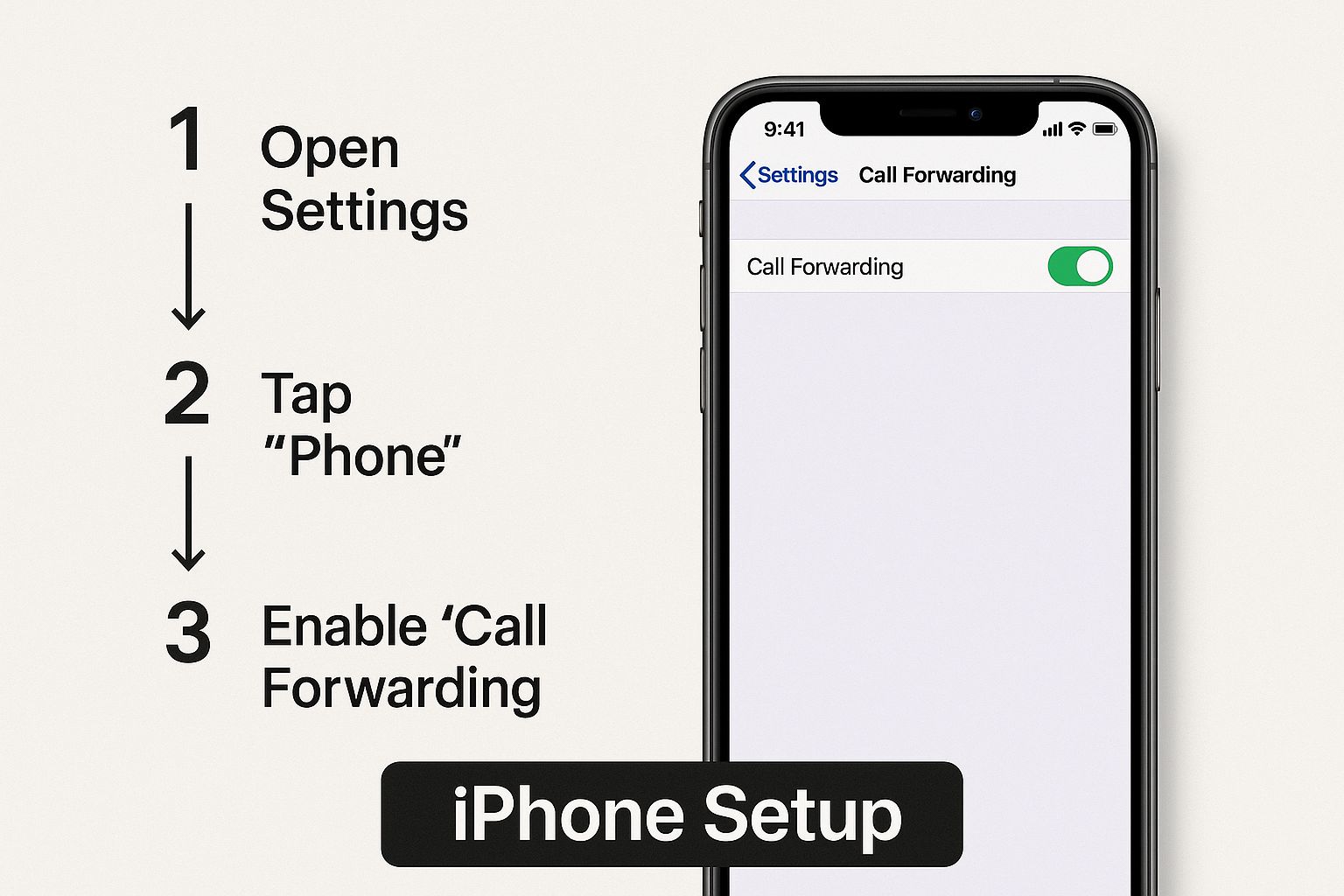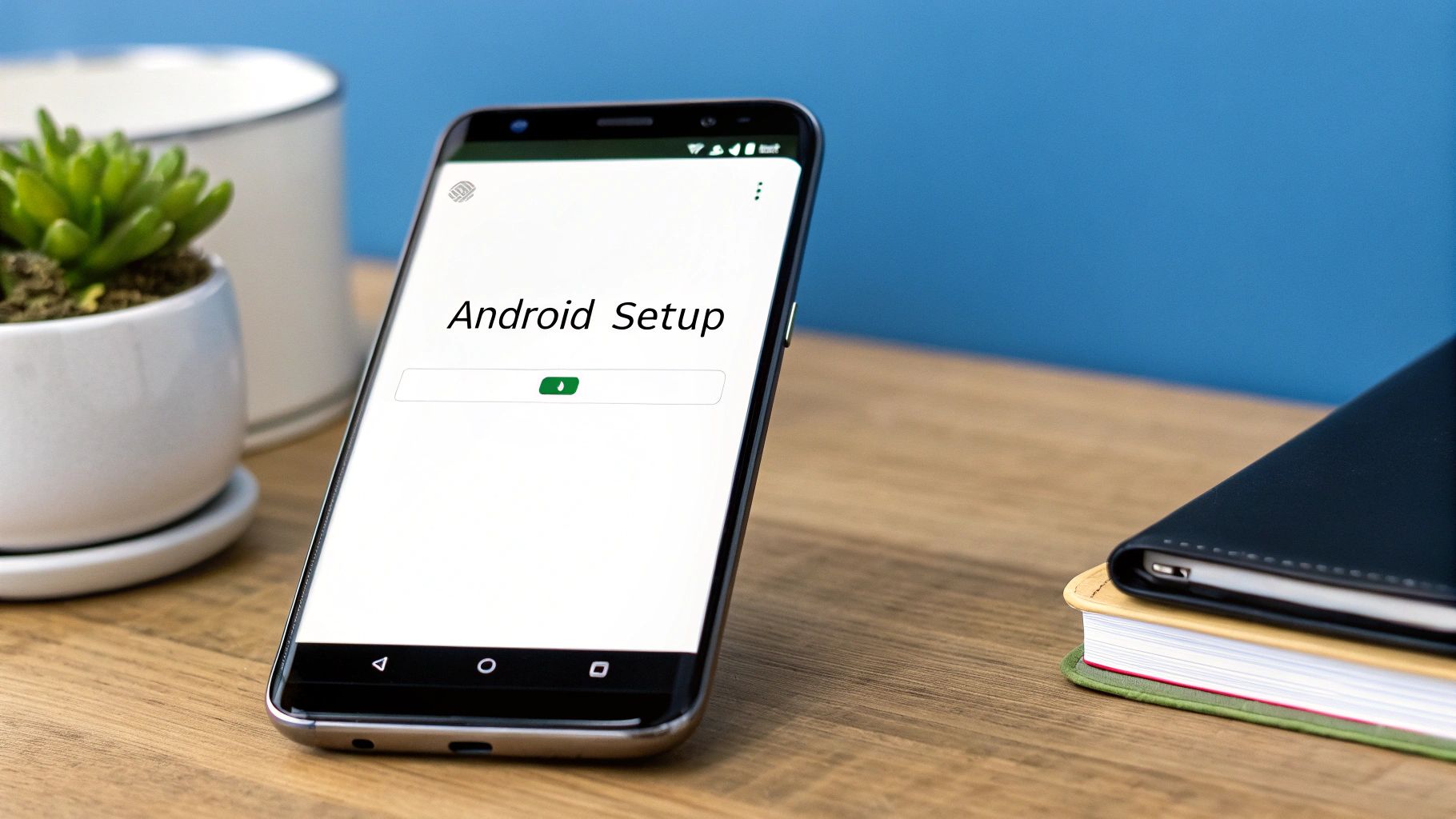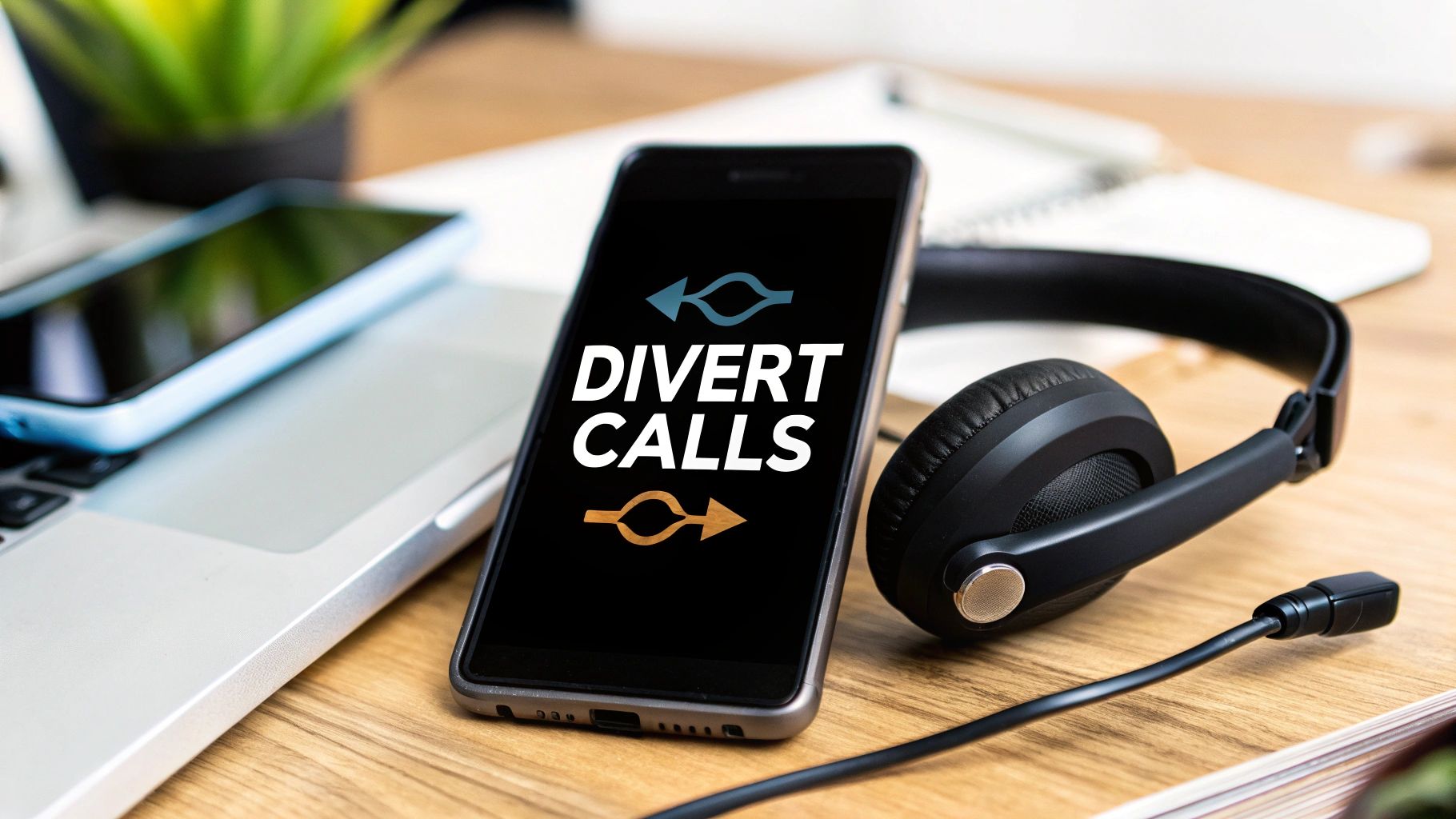Diverting calls to another number is a simple concept, but getting it right is fundamental to maintaining business continuity and great customer service. Whether you’re using your mobile phone's built-in settings, a landline provider’s star codes, or a business phone system like Cloud Move, the goal is the same: to automatically redirect incoming calls to the right person, wherever they are.
Why Smart Call Diversion Is a Business Necessity

Knowing how to divert calls is more than just a convenience—it’s a strategic pillar for any resilient business. At its core, call diversion (often called call forwarding) is a telephony feature that simply redirects a call from one number to another destination.
It’s the foundational element for more complex call routing strategies, which might involve automated menus or skill-based logic to send callers to the best department. But it all starts with the simple, powerful act of diversion.
Putting It Into Practice
Think about it in real-world terms. You're a real estate agent out at a property viewing and an urgent call comes in from a potential buyer. You can't answer. With call diversion, that call is instantly sent to your assistant back at the office, making sure the lead isn't lost.
Or, imagine a service business after hours. Instead of calls hitting a silent voicemail box, they can be diverted straight to an on-call technician's mobile. That’s how you provide crucial 24/7 support. This capability isn't a luxury; it's essential for any modern enterprise.
The Tangible Business Benefits
A smart call diversion strategy delivers some very real advantages that show up on your bottom line and in your customer reviews.
- Boost Customer Satisfaction: Connecting callers to a real person, even when the main line is busy or you're out of the office, makes a world of difference. It cuts down on frustration and dramatically improves their perception of your business.
- Create True Operational Agility: Your team can stay connected and productive from anywhere. Whether they're working from home or traveling for a conference, calls to the main office line can follow them. No more communication gaps.
- Never Miss a Lead: Every unanswered call is a potential lost sale or an unhappy client. Call diversion is your safety net, ensuring every one of those valuable connections is made.
Call diversion transforms your communication from a static, location-based system into a dynamic, flexible network that adapts to your business needs, ensuring you're always available to your clients.
This need for agility is clearly reflected in the market. The call center market in the Middle East is valued at around USD 6.3 billion and is expected to grow significantly, largely driven by cloud-based call management solutions.
For businesses just starting out, understanding these seamless communication strategies is as crucial as navigating the initial company formation in the UAE. It’s this kind of forward-thinking technology that allows businesses to maintain a competitive edge from day one.
Choosing the Right Call Diversion Method
Deciding how to forward your business calls isn't just a technical footnote; it’s a core decision that shapes your customer experience and team's workflow. The best way to divert calls really comes down to your company's size, call volume, and what you’re trying to achieve. Let's walk through the options, from the simplest fixes to more robust business systems, so you can find the right fit.
It's important to see this as more than just routing a call from A to B. Each method offers a different level of control, professionalism, and scalability. Getting this right means building a communication system that helps you grow, not one that holds you back.
Mobile Phone Call Forwarding
The quickest and easiest way to get calls forwarded is right in your pocket. Every modern smartphone, whether it's an iPhone or an Android, has a built-in call forwarding feature. A few taps in your settings, and you can send all incoming calls to another number instantly.
This is a great temporary fix, perfect for a solo operator who’s about to step into a meeting and needs their partner to cover for an hour. The problem is, that simplicity comes at a cost. You get no professional bells and whistles—no business hours, no greeting menus, no analytics. It’s a functional tool for a one-person show, but it’s not a business system.
Landline Provider Call Diversion
If your business still runs on a traditional landline, your provider almost certainly offers a call diversion feature. It usually works by dialing a specific code, like *72, followed by the number you want to forward calls to. This is a reliable, old-school way to send your main office line to a mobile phone when everyone’s gone home for the day.
The biggest issue here is a lack of flexibility. You often have to be physically at the desk phone to turn it on or off, and setting up any kind of complex schedule is usually out of the question. It works, but it’s a rigid solution for businesses with very straightforward, predictable needs.
Choosing a call diversion method isn't just a technical decision; it's a strategic one. The right system can scale with you, providing the tools needed to manage customer interactions professionally as your business grows.
Modern VoIP and Cloud Phone Systems
This is where things get interesting for any serious business. With a Voice over Internet Protocol (VoIP) system, like the ones we provide at Cloud Move, your phone system runs over the internet. This completely untethers you from a physical line and opens up a world of flexibility.
Instead of dialing star codes, you log into an online dashboard. From there, you can build smart, sophisticated rules for how your calls are handled. For example, you could set up a flow that sends calls to your sales team between 9 AM and 5 PM, but automatically diverts them to an after-hours voicemail or an on-call technician’s mobile in the evening.
With a cloud phone system, you can easily:
- Set Up Time-Based Routing: Automatically send calls to different people or departments based on the time of day or day of the week.
- Enable Simultaneous Ring: Make multiple phones ring at once—your desk phone, your mobile, your colleague’s phone—so the first person free can grab the call.
- Access Advanced Analytics: See exactly how many calls you're getting, how long customers are waiting, and other critical data to help you improve your service.
VoIP is the clear winner for any growing business that wants to sound professional without the enterprise-level price tag. It’s the perfect middle ground between basic forwarding and a full-blown call center, giving you the tools to present a polished image to every single caller.
To help you visualize the differences, here’s a quick breakdown of how these methods stack up against each other.
Comparison of Call Diversion Methods
| Method | Best For | Key Features | Limitations |
|---|---|---|---|
| Mobile Phone | Solo entrepreneurs, temporary use, personal forwarding. | Instant setup via phone settings; no extra cost. | Lacks professional features (e.g., business hours, menus); tied to a single device. |
| Traditional Landline | Small offices with a single, fixed phone line. | Reliable connection; managed by the provider. | Inflexible; requires physical access to change settings; no advanced features. |
| VoIP/Cloud System | SMBs, growing teams, and remote workforces. | Online management dashboard, advanced routing, analytics, scalability. | Requires a stable internet connection; can have a slight learning curve. |
Ultimately, the best choice depends on where your business is today and where you plan to take it tomorrow. While a simple mobile forward might work for now, a cloud-based system provides the foundation for professional communication that can grow right alongside you.
How to Set Up Call Diversion on Any Device
Setting up call diversion really depends on the tools you're using. The core idea is always the same—get a call from point A to point B—but how you do it can vary quite a bit. Let's break down the process for the two most common scenarios in business: setting it up directly on a mobile phone versus managing it through a proper cloud phone system.
Knowing the ins and outs of both ensures you can manage your calls effectively, whether you just need to step away for a meeting or you're building a permanent, robust call routing strategy. The aim is to make the entire experience smooth for your customers and your team.
Setting Up Call Diversion on Mobile Phones
For a quick and simple redirect, your smartphone is usually the fastest way to get it done. Both iPhones and Androids have built-in call forwarding settings, which are perfect when you need to divert calls on the fly because you're temporarily unavailable.
This image shows you exactly where to find the call forwarding option in an iPhone’s settings menu. It's usually just a few taps away.

As you can see, you don’t need any special apps to get this working. It’s a straightforward feature that lets you make immediate changes.
How to Forward Calls on an iPhone
On an iOS device, the process is pretty direct. You'll be setting up what's called an "unconditional" forward, meaning every single call that comes to your number gets sent to the new one.
- First, head over to your Settings app.
- Scroll until you find the Phone menu and tap it.
- From there, select Call Forwarding and simply toggle the switch on.
- You'll then be prompted to type in the full phone number you want your calls sent to.
Once it's active, you'll see a little icon in your status bar—a phone with an arrow—letting you know that your calls are being diverted.
How to Forward Calls on an Android Device
Android phones give you a bit more flexibility, letting you decide when your calls get diverted. This is where it gets really useful for business.
- Start by opening your Phone app and tapping the three-dot menu icon to find your Settings.
- You’ll need to look for a menu item like Calling accounts or Supplementary services, and then find Call forwarding.
- This is where you get to choose the rules:
- Always forward: This sends all your incoming calls to the other number, no exceptions.
- Forward when busy: A great option. It only diverts calls if you're already on the phone.
- Forward when unanswered: If you don't pick up after a few rings, the call gets redirected.
- Forward when unreachable: This one's a lifesaver. If your phone is off or has no signal, the call automatically goes to the other number.
These conditional options are fantastic for creating a simple but effective safety net. It’s an easy way to make sure a colleague can grab a call if you happen to miss it.
Activating Forwarding in a Cloud Phone System
While forwarding on your mobile is handy for personal use, a professional setup demands more. This is where a cloud-based phone system like Cloud Move really shines. You move beyond basic redirects and start building intelligent, automated call flows from a single dashboard that covers your entire company.
With a cloud phone system, you're no longer just forwarding calls; you're designing a customer journey. You can create rules based on business hours, team availability, or caller input, ensuring every interaction is handled perfectly.
This level of control is simply impossible with standard mobile settings. You can, for instance, set a rule that automatically diverts any calls coming in after 6 PM to an external answering service. Or maybe you want to route calls from a VIP client directly to a senior manager’s mobile, bypassing the main line entirely.
You can also integrate these systems with other business tools. For example, understanding how to set up Microsoft Teams Voice allows you to extend this control even further, creating a truly unified communication strategy across the whole organization.
Navigating Call Forwarding Rules in the UAE

Setting up call diversion in the UAE isn't just a technical task—it requires a sharp understanding of the local telecommunications landscape. The region has some very specific rules that can directly affect how your business forwards calls, particularly when international numbers are part of the equation.
These regulations are largely in place to protect the infrastructure and revenue of local providers, but for a business, they can present some real hurdles. If you don't account for them from the start, you could be looking at blocked calls, subpar quality, and a poor experience for your customers.
Understanding VoIP and Caller ID Restrictions
One of the biggest things to get right involves Voice over Internet Protocol (VoIP) and how caller IDs are handled. The UAE and its GCC neighbors have strict policies on VoIP services and call signaling.
Here’s a common scenario: authorities might automatically block an incoming international call if it shows up with a local UAE number as its caller ID. This is a frequent issue for businesses that use global cloud phone systems to maintain a local presence.
So, a call coming from your London office that’s diverted to a salesperson's mobile in Dubai could easily get flagged and dropped before it even connects. These measures are designed to bolster cybersecurity and support local telecom operators, but they have a direct impact on your call diversion strategy. In my experience, businesses can see costs jump by 20-30% when they switch to verified local infrastructure to solve this, compared to what they might pay for less restricted VoIP services. You can get more details on the nuances of calling Middle Eastern countries on GlobalCallForwarding.com.
Best Practices for Regional Compliance
To keep your call diversion running smoothly and, most importantly, legally, you need to adopt best practices built for the region. This is about more than just dodging penalties; it's about making sure you have a reliable line of communication to your clients.
Here are a few practical steps to stay on the right side of the rules:
- Use Verified Local Numbers: Make sure the final destination for any diverted call is an officially registered UAE number. This is the clearest way to show local networks that your calls are legitimate.
- Work with Compliant Providers: Team up with a telephony partner like Cloud Move that already has solid relationships with local carriers, namely Etisalat and DU. This is a game-changer because they've already done the hard work of ensuring their routing meets all regional protocols.
- Be Transparent About Costs: Forwarding calls internationally can come with a different set of charges. Get a clear picture of the cost structure from your provider and build it into your communications budget so there are no nasty surprises down the line.
By proactively aligning your call forwarding strategy with local regulations, you can avoid service disruptions and build a reliable communication framework. Think of compliance not as a barrier, but as the foundation for successful, long-term business operations in the UAE.
Advanced Call Diversion Strategies for Growth
Once you’ve got the basics of forwarding down, you can start building a much smarter communication system. This is where simple call diversion evolves into a powerful tool for improving the customer experience and making your team more efficient.
Instead of just dumping all calls to a single backup number, you can create dynamic rules that adapt to what’s happening in your business right now. You’ll be moving from just reacting to calls to proactively managing your entire communication flow.
Implement Time-Based Routing
One of the most practical and effective strategies I've seen is time-based routing. This lets you automatically send calls to different places depending on the time of day or the day of the week, and it's a lifesaver for managing workloads.
For instance, you can have all calls during business hours—say, 9 AM to 6 PM—ring your main office line. But after 6 PM, they can automatically forward to an after-hours answering service or a designated on-call mobile number. On weekends, maybe those calls go straight to a voicemail that emails transcripts to your support team.
It’s a simple setup that guarantees every caller gets a timely, appropriate response, no matter when they decide to reach out.
Use Skill-Based Call Distribution
For any business with specialized teams, skill-based routing is an absolute game-changer. Think about it: instead of a customer with a complex technical question landing with a general salesperson, you can get them directly to an expert who can actually solve their problem.
This is usually handled with an Interactive Voice Response (IVR) menu. A caller might hear, "Press 1 for Sales, Press 2 for Technical Support." Their choice instantly diverts the call to the right department or even a specific person, which dramatically cuts down on resolution times and customer frustration. For anyone serious about optimizing their sales funnel, understanding effective lead routing best practices is a critical piece of this puzzle.
A well-designed call diversion strategy does more than just redirect calls; it actively guides customers to the fastest, most effective solution, reducing frustration and building loyalty with every interaction.
This kind of sophisticated setup relies on a strong digital backbone. The UAE's continued investment in smart city tech and data centers—a market expected to reach nearly USD 19.9 billion by 2030—is what makes these advanced telecom capabilities possible. This robust infrastructure allows businesses to implement complex call diversion rules that integrate seamlessly with CRM systems and analytics. You can find more details on this growing data centre market on Business Wire.
Best Practices for Advanced Setups
As you start putting these more advanced strategies into practice, there are a few key principles I always recommend to keep the experience smooth for your customers.
- Record a Professional Greeting: Don't just silently forward the call. Always let callers know their call is being redirected. A simple, reassuring message like, "Thank you for calling. We're connecting you to the next available specialist," goes a long way in managing expectations.
- Test Your Rules Regularly: This is a step people often forget. Make a habit of calling your own number at different times and days to make sure your time-based and skill-based rules are firing exactly as you expect.
- Analyze Call Data: Your VoIP system is a goldmine of information. Use its analytics to look at your call flows and spot any bottlenecks. By tracking key metrics, you can make smart, data-driven tweaks to your setup. If you're not sure where to start, you can learn more about which contact centre KPIs are most important in our detailed guide.
Common Questions About Call Diversion Answered
https://www.youtube.com/embed/IFTdyc2G_yc
Even with a solid plan in place, it's natural to have questions about the nuts and bolts of call diversion. Let's walk through some of the most common things business owners ask when they first learn how to divert calls to another number.
A classic question we hear all the time is, "Can I actually forward my office landline to my mobile?" Absolutely. Modern landline providers and especially VoIP systems are built for exactly this scenario, ensuring you never miss an important call just because you've stepped away from your desk.
Another big concern is what the customer experiences. Do they have any idea their call is being rerouted? With a professionally configured system, the entire process is invisible to them. They just hear a normal ring tone before being connected, which keeps your business looking sharp and professional.
How Caller ID and Forwarding Work
One area that often causes a bit of confusion is caller ID. When a call gets forwarded, whose number shows up—the original caller's or the line that forwarded it?
In almost all business setups, the system is designed to show the original caller’s number. This is a critical detail. It gives the person answering the phone the context they need to greet the caller properly and be prepared for the conversation.
The real magic of a well-implemented call diversion system is that it’s completely transparent for your team but invisible to your customer. Your staff gets the information they need, while the caller just gets a fast, seamless connection.
Finally, let's clear up the difference between the two main types of call forwarding.
- Unconditional Forwarding: Think of this as the "all-in" option. Every single call is immediately sent to the new number without the original phone even ringing once. It's the perfect solution for holidays or when you know an office will be empty for a while.
- Conditional Forwarding: This is the smarter, more flexible choice. Calls are only diverted if a specific rule is triggered—for example, if your line is busy, if you don't answer after four rings, or if your phone is switched off. It acts as a brilliant safety net to catch calls that might otherwise be lost.
Getting these details right is key to fine-tuning your setup and boosting your team's efficiency. To learn more about measuring that success, take a look at our guide on the most important key performance indicators for customer service.
Ready to build a smarter, more responsive communication system? Cloud Move delivers powerful, flexible telephony solutions that grow with your business. Book a free demo today and discover how we can help you connect with every customer, every time.




